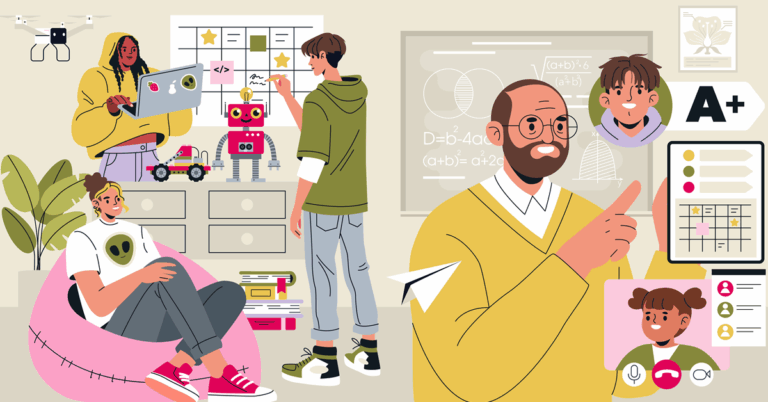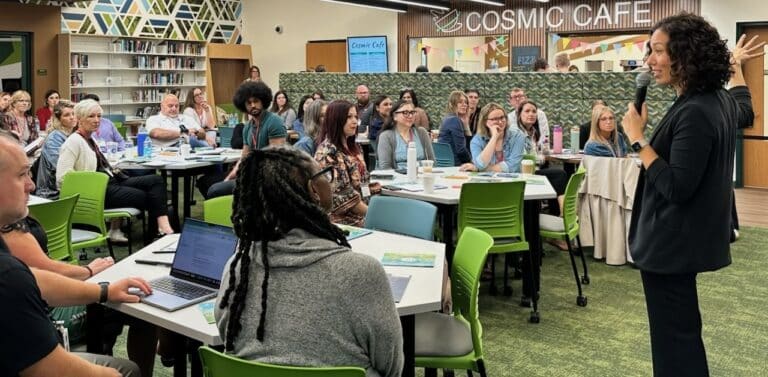Advancing Student-centered Learning
At KnowledgeWorks, we believe that all children can learn and should be challenged to take ownership of their learning to effectively build the knowledge and skills they need for the future.
What is student-centered learning?
A student-centered environment facilitates a more collaborative way for students to learn. And although a foundational shift from a traditional classroom, a student-centered approach does not eliminate the teacher. The teacher models instructions and acts as a facilitator, providing feedback and answering questions when needed. It’s the student that chooses how, why and with whom they want to learn. Students collaborate with each other and give each other feedback, using the instructor as a resource when needed. Through relevant, meaningful opportunities to acquire knowledge, skills and dispositions, each student realizes their fullest potential.
How do student-centered learning and personalized, competency-based learning work together?
Trends in education evolve over time, but what has never changed for us is keeping students at the center of what we do. During more than 25 years of partnering with states, communities, districts and schools, we’ve helped lead interest-based academies, early college high schools, project-based learning, competency-based education and personalized learning. Each of these student-centered approaches can work, and with personalized, competency-based learning we’re building upon that previous work to create environments where learners and educators thrive.
Through personalized, competency-based learning, learners have voice and ownership over how, what, when and where they learn – and connections to community and real-world experiences are a priority. Students learn actively using different pathways and varied pacing that does not result in tracking or other forms of ability grouping. The core elements of personalized, competency-based education – engaging educational experiences, focus on learners’ needs, assets and voice, connections to real-world experiences, emphasis on readiness and de-tracking – have a substantial body of research and evidence supporting their efficacy in closing opportunity gaps and producing more equitable outcomes.
What is personalized, competency-based learning?
In a personalized, competency-based learning environment:
- Students daily make important decisions about their learning experiences, how they will create and apply knowledge and how they will demonstrate their learning
- Assessment is a meaningful, positive and empowering learning experience for students that yields timely, relevant and actionable evidence
- Students receive timely, differentiated support based on their individual learning needs
- Students progress based on evidence of mastery or competency, not seat time
- Students learn actively using different pathways and varied pacing
- Strategies to ensure equity are embedded in the culture, structure and pedagogy of schools and education systems
- Rigorous, common expectations for learning are explicit, transparent, measurable and transferable
Source: Aurora Institute
What's in a name?
Why implement personalized, competency-based learning?
A personalized, competency-based approach can work for students of all ages and supports educators in connecting with what they love about teaching and learning. Communities benefit from strong partnerships and support making real-world connections for learning. When implemented well, children as young as kindergarten know what they need to learn and how to work independently.
Get an understanding about what personalized, competency-based learning looks like in practice with these resources:
- What is the role of a teacher in a personalized, competency-based learning classroom? Read more »
- An emphasis on agency and continuous growth and improvement is key to these districts’ shift to personalized, competency-based learning. Read more »
- How a fresh approach to standards in one district is supporting students to reach mastery no matter where they begin their learning journeys. Here’s how »
- What’s the difference between traditional, and student-centered classroom management and why does it matter? Read more »
- An increase in learner agency and a decrease in chronic absenteeism in this district demonstrate the value of personalized, competency-based learning. Read more »
- North Dakota’s four-district cohort grew into a statewide network of learning communities in support of and sustaining personalized, competency-based learning. Here’s how »
Making the Case: Compelling Data
Visit Making the Case: Compelling Data to browse our growing library of data points that describe the impacts and outcomes of student-centered and competency-based approaches to teaching and learning.

